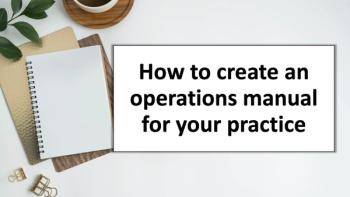
Medication for All
PAPs, operated by drug manufacturers and other organizations, are a lifesaver to some patients, but they can also be a burden to medical office staff and physicians.
Finding affordable medications for her patients was an all-too-familiar challenge to Charlene Hannam of Marshalltown, Iowa. After three decades as a nurse, Hannam knew the shortcuts needy patients take when it comes to keeping their medical costs down -- taking one pill every other day instead of daily, or once a day instead of twice. Or simply accepting the prescription with no intention of filling it.
Today, though, Hannam is able to get free or reduced-price medications for those same patients through a program called Medical Assist, which was established by a local hospital. Medical Assist volunteers like Hannam, who's now retired, help complete applications for low-income patients who may qualify for such so-called Patient Assistance Programs (PAPs) that are designed to ensure these patients get and take their medicines without breaking the bank.
PAPs, operated by drug manufacturers and other organizations, are a lifesaver to some patients, but they can also be a burden to medical office staff and physicians, who must sign off on the paperwork. Some feel they are simply too much trouble.
But as Hannam's experience shows, it may not be necessary to go it alone when it comes to enrolling your patients in PAPs. There are ways to reduce the hassles, including tapping into community organizations, using specialized software, and going online to PAP Web sites where forms and assistance can be found.
How PAPs work
The patients Hannam helps in the Medical Assist program are among the millions nationwide who have benefited from PAPs, according to Mark Grayson, deputy vice president of the Pharmaceutical Research and Manufacturers of America (PhRMA), which represents major pharmaceutical and biotechnology companies.
Forty-eight PhRMA members offer 400 discounted or free medications to qualified patients through the industry's Web site,
Patients typically qualify for such programs based on financial need. Many programs will only consider patients who have no prescription drug benefit from any source; some may accept those who have exceeded their benefits.
Physician offices may contact a drug manufacturer directly to inquire about a medication for a patient. PhRMA publishes a directory of PhRMA members' contact information for anyone to use. Practices can request an application by phone, which the manufacturer will mail or fax to the office; many can also be printed out from Web sites.
Manufacturers generally issue enough medication for a three-month supply, and it can either be sent to the physician's office or to the patient's home. For refills, some PAPs may request an entirely new application, while others might require a brief update or confirmation of information.
As of June, generic drugs have also become available to low-income patients for a small administrative fee through Rx Outreach, which is operated by nonprofit Volunteers in Health Care. The group's Web site,
The generic drug program appears to have many advantages over PAPs that provide brand name medications, including less restrictive income requirements and more medication allowed per prescription (up to a year's supply in some cases).
"The program is easy for physicians to use," says Stephanie Geller, director of research for Volunteers in Health Care. "All they have to do is sign the form and provide a prescription. The eligibility criteria are very generous. Patients with incomes as high as 250 percent of the federal poverty level are eligible and no documentation of income is required." People are eligible regardless of their insurance status.
Getting help with PAPs
Physician offices don't have to be overwhelmed by the administrative aspects of PAPs -- they can choose to be as involved as they want, says Geller. "There are some doctors' offices that are willing to take on the whole task," such as determining eligibility for patients and completing all the necessary paperwork.
A practice could obtain the forms and have the patient fill them out, or seek help from community-based organizations or local government entities such as the department of aging. Church groups and pharmacists may be willing to help. Your local hospital may also be a good source for assistance.
According to Hannam, physicians at McFarland Clinic, a large multispecialty practice in Marshalltown, worked with Marshalltown Medical & Surgical Center officials to start Medical Assist. "The nurses were doing it without pay [before] and the doctors felt like they needed something better," Hannam says.
Now a hospital employee oversees the efforts of Hannam and other volunteers, who not only process PAP applications, but also distribute and track the medications obtained for patients. The hospital benefits, too. Marshalltown Medical & Surgical Center found that once the program was in place, fewer patients were coming to the emergency room to try to obtain medications, Hannam says.
Medical groups, the pharmaceutical industry, and others are aware of the many hoops associated with PAPs, and have sought ways to reduce them. Many of the improvements come in the form of new tools added to online versions of PAPs.
Several sites, including Volunteers in Health Care's
To cut the administrative work for offices that handle PAP applications for more than a handful of patients, Volunteers in Health Care sells software, called RxAssist Plus that allows users to fill out application forms automatically and track the process.
"The standard price for RxAssist Plus is $800 per year, but we offer a discounted rate of $200 per year to physician practices, nonprofit organizations, and government agencies," says Geller. Offices that handle a smaller volume could keep track of these patients with a simple filing system, she says.
The most recent feature on PhRMA's site,
An "eligibility wizard" on the site will search for PAPs and a name and contact information for any other program that the person might qualify for in their state. Basic questions such as household income and size are all that are needed to determine eligibility for assistance.
The site does have its limitations: For now, the site cannot store information, so it must be reentered each time medication is sought.
"Some people feel like that's good, some feel that's bad. We are looking at security precautions to find a way to do that," Grayson adds.
Barriers remain
The American Academy of Family Physicians (AAFP) recently worked with Volunteers in Health Care to study the barriers to accessing PAPs. To research the issue, Geller visited practices in Maine, New Mexico, and Texas that represented a cross-section of medical offices.
She visited the practice of Linda Stogner, MD, medical director of Hope Medical Center, a community health center in rural Estancia, N.M., a town of 1,300 about 60 miles east of Albuquerque.
Stogner notes that it's still unclear how PAPs will mesh with new Medicare discount drug cards, adding that AAFP will need to make certain all its information is current before making any recommendations on improvements to PAPs.
About 10 percent of Stogner's patients receive medications through PAPs -- about half of those who could probably benefit from them. Stogner recommends appointing one individual (a part-time nurse, in her case) to handle all PAP applications so that person can become more adept at the process, and getting patients involved.
"One of the things we somewhat insist on is that it is [patients'] responsibility to fill out the paperwork. We will go over it with them. We will give them the 800-number and they can call and get the forms," Stogner says.
She would like to see a uniform application and process for obtaining medications that would be accepted by all drug makers. But physicians themselves could do more to obviate the need for expensive medications, she claims.
"I am very aware of the cost of the medications that I prescribe for my patients," Stogner says. "I consider whether there is a less expensive alternative I can use." She also looks for signs that patients might be stretching their medication out, and tries to keep track of when less expensive generic equivalents become available.
And clearly, offices must be online to take full advantage of some of the best ways to streamline PAP management. Still, some practices aren't there yet.
Cindy Kemp, RN, nurse manager for a five-physician hematology/oncology practice in Rockville, Md., says her office processes PAP forms for about five patients per month. Kemp is looking forward to using PAP Web sites to speed the process along. Her office has been doing the forms by hand, and recently added Web access to the practice.
Kemp's office encourages patients to complete what they can of the application forms, while nurses complete the rest. "It might take 45 minutes to fill out the paperwork. It just depends on the company. Some require a diagnosis and history; some only want to know the name of the medication and the dose," Kemp says.
But, she adds, "some patients really need our help, and we don't mind doing it."
"People are always telling us it makes such a change in their lives" to be able to take their medications correctly, and have them paid for, Hannam says.
Theresa Defino is a freelance medical writer with 15 years' experience covering economic, legislative, and clinical aspects of healthcare issues. She has written for WebMD and edited such publications as Managed Care Week, Medicare and Managed Care Strategies, and Practical Guidance on HIPAA and E-Health for Physicians Practice. She can be reached at
This article originally appeared in the September 2004 issue of Physicians Practice.
Newsletter
Optimize your practice with the Physicians Practice newsletter, offering management pearls, leadership tips, and business strategies tailored for practice administrators and physicians of any specialty.










